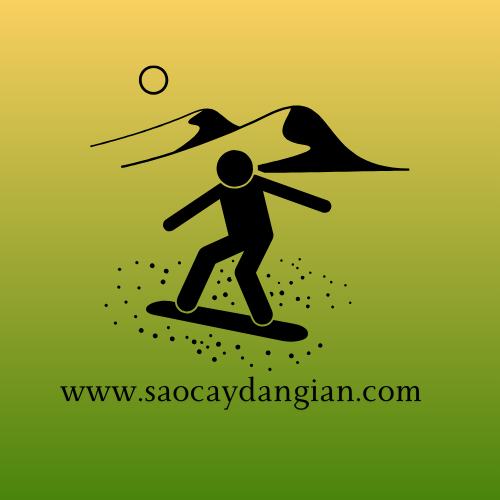
“Environmental impact of sandboarding: Details and tips to minimize the impact” introduces the impact of sandboarding on the environment and how to minimize its effects.
Environmental impact of sandboarding activities
Affects river ecology and ecosystems
Unsustainable sand mining causes serious changes to river ecology and riverine ecosystems. Excessive sand sliding leads to loss of habitat for aquatic and invertebrate species. In addition, noise and movement during river sand mining can also drive away wildlife along the riparian zone.
Affects groundwater levels and tidal regime
Excessive exploitation of river sand also directly contributes to lowering the water table. Sediment deficits caused by mining within the estuary or upstream of the river, can increase tidal intrusion into the estuary, tidal range and peak tidal flow. This can create erosion channels in the river bottom and affect the river's tidal regime.
Affects the river's geomorphological structure
Unsustainable sand mining also changes the geomorphological structure of the river, leading to changes in riverbed morphology and river bank erosion. This could affect food security and the possibility of complete disappearance of the Mekong Delta in the future.
Details about the impact of sand sliding activities on the environment
Impact on the ecosystem
Unsustainable sand sliding causes destruction of riverine and aquatic habitats, affecting local flora and fauna. It also leads to loss of habitat and cover for river beds, affecting the density of invertebrate and fish populations on the river bottom. Noise and movement during river sand mining by heavy industrial equipment can drive away wildlife along riverine areas.
Impact on river geomorphological structure
Sand sliding activity also affects the river's geomorphological structure. Research shows that the river bottom has undergone unusual and significant changes, with the appearance of many more river bed cuts and an increase in both the size and depth of the holes in the river bottom. This can lead to changes in riverbed morphology and a significant decrease in the rate of ocean progression, affecting people's livelihoods and riverside infrastructure.
These impacts all have serious consequences for the environment and need to be managed and minimized to protect resources and community livelihoods.
Tips to minimize the effects of sandboarding activities

1. Use sustainable sand mining methods
– Use sustainable sand mining methods such as riverbed sand mining instead of surface mining.
– Apply modern technology to minimize impact on the environment and riverside ecosystem.
2. Strict management and supervision
– Establish a strict management and monitoring system to control illegal sand mining.
– Strengthen inspection and handling of illegal sand miners to ensure compliance with legal regulations.
3. Search for alternative material sources
– Encourage the use of construction material sources to replace river sand such as recycled sand and artificial sand.
– Research and develop construction methods using alternative materials to minimize dependence on river sand.
Tools and techniques to minimize environmental impact when participating in sandboarding activities
Tools to minimize environmental impact
– Use an effective wastewater treatment system to prevent toxic discharge into the environment.
– Apply green and clean technology to minimize emissions and air pollution during sandboarding activities.
Techniques to minimize environmental impact
– Optimize the sand mining process to minimize river bank erosion and river tributary erosion.
– Use sustainable sand mining methods, to maintain ecological balance and ensure the regeneration of river sand resources.
Applying tools and techniques to minimize environmental impacts when participating in sandboarding activities will help protect the environment and maintain ecological balance in the Mekong Delta region.
Apply methods to minimize environmental impacts in popular sand sliding areas
Method 1: Use sustainable sand mining techniques
To minimize environmental impacts in popular sand sliding areas, the adoption of sustainable sand mining techniques is important. Thereby, we need to learn and apply sand mining methods without greatly affecting the environment, ensuring the sustainability of resources.
Method 2: Use environmentally friendly construction technology
The use of environmentally friendly construction technology is also a method of minimizing environmental impacts in sand sliding areas. This technology helps reduce the amount of sand used in construction, thereby minimizing the impact on sand resources and the surrounding environment.
Conclude
Vietnam's Mekong Delta (MRD) is facing serious challenges due to unsustainable sand mining. Erosion of river branches, bank erosion, and the resulting impact on the environment and ecosystem are having a significant impact on people's lives and the sustainable development of this delta.
Main challenges and consequences:
- Erosion of river tributaries and bank erosion, changing the shape of the delta and affecting riverine habitats.
- Lowering the water table and changing the river's tidal regime, affecting plants, animals and fish at the river bottom.
- A significant decrease in the speed of ocean progression and the risk of delta landslides threaten people's livelihoods and agriculture.
The consequences of unsustainable sand mining are changing the low-lying Mekong Delta, which is expected to strongly affect food security and the possibility of the delta completely disappearing in the future. .
Solutions and implementation of sustainable sand mining management project:
- Build a sand bank database for the Mekong Delta and increase community awareness of the impacts of unsustainable sand mining.
- Promote the search for alternative material sources for sand and gravel in the construction sector and develop recommendations and guidelines on sustainable sand mining and integrate it into natural disaster prevention and sustainable development policies.
- Deploying the Sustainable Sand Mining Management Project to minimize the impact of climate change and prevent natural disasters through the participation of the public-private sector in sustainable sand mining in the Mekong Delta.
Sand slides affect the environment by creating air and soil pollution. To minimize this impact, we need to strengthen waste management, wastewater treatment and protect sand sliding areas.



